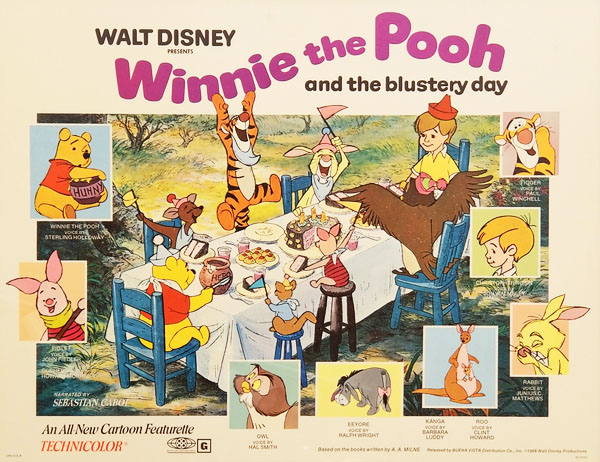
Suspended Animation #385
Oh bother! The bear with very little brain through no fault of his own certainly seems to be a troublesome bruin and for many years caused many difficulties for the Walt Disney Company as it struggled for decades to gain full exclusive rights to the property.
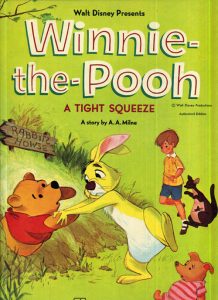 At one point, CEO Michael Eisner even had Clare Milne, the granddaughter of Pooh’s creator, try and terminate the Stephen Slesinger Inc. rights under copyright law in court and then sell those rights to Disney. The fact that at the time Clare was in a nursing home and didn’t understand the difference between a thousand pounds and one million pounds made no difference to Eisner. The courts refused to hear the case.
At one point, CEO Michael Eisner even had Clare Milne, the granddaughter of Pooh’s creator, try and terminate the Stephen Slesinger Inc. rights under copyright law in court and then sell those rights to Disney. The fact that at the time Clare was in a nursing home and didn’t understand the difference between a thousand pounds and one million pounds made no difference to Eisner. The courts refused to hear the case.
For awhile Winnie the Pooh merchandise was selling more than items branded with Mickey Mouse. Currently, it is estimated that Winnie the Pooh brings in three to six billion dollars a year to the Walt Disney Company.
Author A.A. Milne had admired Walt Disney. He even wrote to Kenneth Grahame’s widow about Toad of Toad Hall that, “I expect you have heard that Disney is interested in it? It is just the thing for him, of course, and he would do it beautifully.” When Disney finally made Wind in the Willows, the story reflected Milne’s renowned stage adaptation of the tale as much as the original story.
On July 16, 1961, the Disney Studios obtained rights to make a Winnie the Pooh animated film but it was still years before Walt announced that he was planning an animated feature based on Milne’s books. As Walt continued to discuss the project, he made the decision that American audiences might not fully embrace such a British influenced story and that it was best to begin with a “featurette” to introduce the characters.
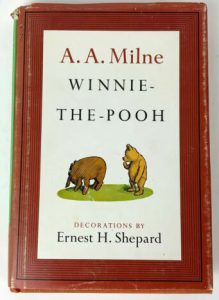 Those who worked with Walt have told me that he still probably had painful memories about the feature length Alice in Wonderland where he felt American audiences didn’t understand the humor of British whimsy.
Those who worked with Walt have told me that he still probably had painful memories about the feature length Alice in Wonderland where he felt American audiences didn’t understand the humor of British whimsy.
While there were many animators on staff who adored the Milne characters and stories, Walt seems to have purposely assigned a production team who were completely unfamiliar with Milne’s work.
Wolfgang “Woolie” Reitherman was assigned to direct and in an interview from that time period seems to take pride in the fact that he had never heard of Pooh until Walt mentioned it in 1961. Woolie felt that he was being punished by being assigned to this mild-mannered featurette, especially since he had just started directing the Disney animated features.
When confronted by British reporters about the absence of the character of Piglet, Woolie responded, “As far as Piglet is concerned, we’re all guilty.” Woolie claimed that when the film was cut from full-length to featurette that Piglet was left on the cutting room floor because there was simply no room for the character.
That remark sparked the ire of the British press, who wanted to know then why there was room for an American gopher. Tigers and kangaroos are not native to the United Kingdom either but their toy counterparts had been purchased in England and the stories indicate that they relocated to the 100 Acre Woods.
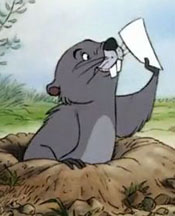 The gopher (voiced by Howard Morris and reminiscent of the beaver character in Lady and the Tramp) was clearly a resident and seemed to indicate the stories took place in the United States.
The gopher (voiced by Howard Morris and reminiscent of the beaver character in Lady and the Tramp) was clearly a resident and seemed to indicate the stories took place in the United States.
The gopher’s claim that “I’m not in the book” (referencing not only that he is a freelance contractor but also that he doesn’t appear in the Pooh books) didn’t seem to produce many smiles from Brits wondering if Walt was trying too hard to Americanize their well-loved stories. The characters, including Christopher Robin, seemed to speak in a Midwest American accent instead of a British one.
“The Midwest accent is the generally neutral accent at which we aim as it is acceptable in the whole American market,” claimed Woolie, who had cast his own son, Bruce, in the role of Christopher Robin, “We’ve got the spirit of Milne and Shepard but it’s Disney, too!”
Christopher Robin was physically changed as well. Animator Hal King said, “Christopher Robin came out too sissified. So we gave him a haircut and some decent clothes.”
Milne’s niece, Angela, who was a regular contributor to Punch magazine, wrote a satirical piece at the time about how “Americanizing” the Pooh stories was her grandfather’s intent all along and that it was the publishers who forced him to retain a sense of British flavor.
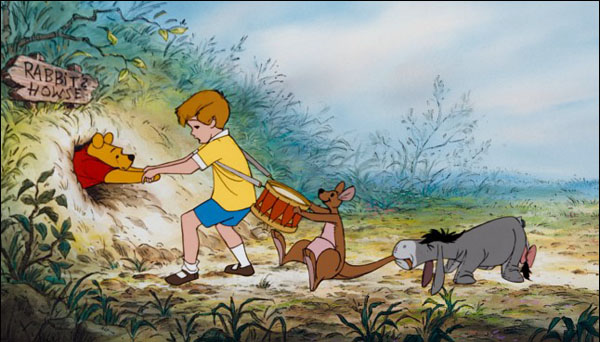
There were complaints about the redesign of Pooh himself. Not realizing the difficulty of animating a stuffed toy (especially in a pre-computer era), complaints were thrown at abandoning the original Shepard design.
Fun was made of Pooh’s red T-shirt, even though Pooh bears wearing such a shirt were authorized and sold at F.A.O. Schwarz store in New York in the 1940s and 1950s. The red shirt first appeared on a record album in 1932. (From an animation standpoint, the T-shirt helps define the character, much like Mickey Mouse’s shorts.)
 Despite the barbs, the “featurette” was popular in the United States and overseas.
Despite the barbs, the “featurette” was popular in the United States and overseas.
Milne’s widow, Daphne, said in an interview:
“Ever since I sold the film rights of the Pooh books to Mr. Walt Disney, I had been wondering with some anxiety what he would make of them in a cartoon. I had confidence in Mr. Disney’s genius for handling imaginative themes yet one never knows whether one is going to agree! On an evening last August, I turned on the television in my London flat to see a brief advance excerpt of the Pooh cartoon being shown in a program of Walt Disney films.
“I was nervous. If I did not like this version of Pooh, I would feel deeply disappointed and hurt. Pooh is part of my life, part of my cherished memories. I leaned forward. There was a nursery scene and a glimpse of Christopher Robin as a child in cartoon. There was the tree in the 100 Aker Wood with bees buzzing about it, and Pooh, attached to a balloon, sailing upwards in search of honey, his favorite food. I relaxed. It was all right. Nothing jarred. I was very relieved.”
 Ernest Shepard, who had illustrated the books and was in his 90s, declared that the Disney version was “a complete travesty.”
Ernest Shepard, who had illustrated the books and was in his 90s, declared that the Disney version was “a complete travesty.”
Despite the success of the featurette (certainly better remembered that the live action film it accompanied in theaters, The Ugly Dachshund), the Disney Company was sensitive to the criticism from the British Isles and in the next featurettes, Piglet returned and Christopher Robin sounded British.
Despite mixed critical reaction to the first featurette, the studio proceeded with another animated featurette, Winnie the Pooh and the Blustery Day, which was released in December 1968. It would later go on to win the Academy Award for Best Animated Short.
However, that rocky beginning was a preview of Pooh problems to come for the Walt Disney Company until it finally obtained the full exclusive rights in 2009. In 2023, Milne’s Winnie the Pooh along with Salten’s Bambi will fall into public domain although Disney still retains the copyright and trademarks to its versions of the characters and the new supporting characters it created. It is ust another set of difficulties for the Walt Disney Company from that silly old bear.


 Jim Korkis is an internationally respected animation historian who in recent years has devoted his attention to the many worlds of Disney. He was a columnist for a variety of animation magazines. With his former writing partner, John Cawley, he authored several animation related books including The Encyclopedia of Cartoon Superstars, How to Create Animation, Cartoon Confidential and Get Animated’s Animation Art Buyer’s Guide. He taught animation classes at the Disney Institute in Florida as well as instructing classes on acting and animation history for Disney Feature Animation: Florida.
Jim Korkis is an internationally respected animation historian who in recent years has devoted his attention to the many worlds of Disney. He was a columnist for a variety of animation magazines. With his former writing partner, John Cawley, he authored several animation related books including The Encyclopedia of Cartoon Superstars, How to Create Animation, Cartoon Confidential and Get Animated’s Animation Art Buyer’s Guide. He taught animation classes at the Disney Institute in Florida as well as instructing classes on acting and animation history for Disney Feature Animation: Florida.




















































You didn’t mention exactly when Michael Eisner tried to negotiate with Clare Milne over the rights to Winnie the Pooh, but your statement is misleading on several counts. Clare Milne, Christopher Robin Milne’s only child and A. A. Milne’s only grandchild, was born with cerebral palsy in 1956, not long after her grandfather passed away. In 1998, two years after Christopher Robin’s death, she received a very large sum in copyright royalties. Her mother (who was Christopher Robin’s first cousin as well as his widow) and their family solicitor used this money to set up a Trust for Clare, buying a house for her in Devon and providing her with round-the-clock care. She was never in a “nursing home” as such. Any negotiations concerning the rights to Winnie the Pooh would have been handled by the Chairman of the Trust, who was the family solicitor. I never thought I’d live to see the day when I’d come to the defence of Michael Eisner about anything, but you make it sound as though he was trying to take advantage of a demented old woman, and Clare’s interests were simply too well looked after for that to happen. Clare Milne died in 2012 at the age of 56, but her Trust continues to support charities for people with disabilities in southwestern England.
That “Winnie-the-Pooh” dustjacket makes me feel very nostalgic, as my family had all four of the A. A. Milne books in the original edition, and my parents used to read them aloud to us at bedtime. The Disney version of the stories and the characters, as appealing as they are, will never hold such a special place in my heart.
I thought the original books already did go pd.
The original Pooh book already did go PD:
https://news.temple.edu/news/2022-01-24/winnie-pooh-and-hundreds-other-works-are-now-public-domain
“Winnie the Pooh and the Honey Tree” was the last piece of new animation released to theatres during Walt Disney’s lifetime.
It was heavily promoted. Mr. Disney need have had no fears about the reception of Pooh among American children. To call it a phenomenon is an understatement. I didn’t know a kid at the time who wasn’t fascinated by the Pooh characters. To this day, I have the plastic figures that came in cereal boxes.
To see Winnie the Pooh in theatres, kids had to sit through the interminable, tedious, and not-too-funny film “The Ugly Dachshund”. It did well at the box office, but only because it was paired on the same bill with “Winnie the Pooh.” As an adult have I been able to appreciate the antics of Dean Jones and Suzanne Pleschette in that film, which is an OK comedy but does not have much in it to appeal to kids–at least as far as my six-year-old self was concerned. But “Winnie-the-Pooh” delighted me so much that I asked my mother to read me my storybook (“Pooh Goes Visiting” with Disney illustrations in place of Ernest Shepard’s) before I could get to sleep that night.
My parents took us to see “Honey Tree” and “The Ugly Dachshund” in 1966 as well. Pairing the two films was a brilliant strategy. Walt had concerns about how “Pooh” would be received and a wacky comedy about doggies was less of a risk, even though “Pooh” turned out to be a phenomenon — and was, Frederick noted, lived up to the promotion and merchandise (I had the Nabisco cereal spoon sitters and two Little Golden Books). So when we went to see the double feature, we first saw “Honey Tree,” watched “Dachshund,” and stayed to see “Honey Tree” again.
“The Ugly Dachshund” could not possibly compete with traditionally animated “Pooh,” and even a less-than-enthusiastic artistic assignment (few at the time were thrilled to work on “Alice in Wonderland” but it also gets better and better with every passing year). produced outstanding results from Walt Disney’s staff.
I also did not appreciate “The Ugly Dachsund” as much then as I do now, since it’s a vintage Disney situation comedy — the equivalent of “Hazel” or “Bewitched” (ever notice how Disney films and Screen Gems shows have that kind of specific signature style?). It’s also nice to hear Thurl Ravenscroft narrate the record album and sing a little Sherman song.
https://www.youtube.com/watch?v=RG8XZXZ9ezggrego
Yes, I noticed the similiar style, though Don “My 3 Sons/Family Affair” Fedderson shows could be put in there, what with all the Disney actors HE used/.
I remember Pooh, and Dachshund in theatres,too.. would rather watch the Dean Jones-Suzanne Pleshette one now than H-B’s Scooby Doo.
Did Disney himself understand British whimsy, which tends toward the silly and childlike (e.g. Monty Python)?
The primary trap of attempting to animate the Pooh Corner characters is their gentleness; even Tigger needn’t be nearly as cyclonic as the Disney version voiced by Paul Winchell (and afterward by imitators). And God help them in the public domain; you’ve undoubtedly heard of the current slasher Pooh movie.
“There was no room for Piglet” is probably the saddest sentence I’ve come across in a long time.
Hey, they made up for the lack of Piglet in the next film and as mentioned, “Blustery Day” won for “Best Animatied Short Subject” of 1968.
I found The Ugly Dachshund movie in a discount DVD bin a while back. I liked it a lot. But then, I’m a sucker for dog movies.
This just reminds me there needs to be a complete DVD release of the Pooh TV show. Yes, in Europe too, with all the dubs they can get.